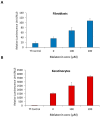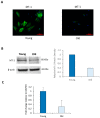Age Associated Decrease of MT-1 Melatonin Receptor in Human Dermal Skin Fibroblasts Impairs Protection Against UV-Induced DNA Damage
- PMID: 31947744
- PMCID: PMC6982064
- DOI: 10.3390/ijms21010326
Age Associated Decrease of MT-1 Melatonin Receptor in Human Dermal Skin Fibroblasts Impairs Protection Against UV-Induced DNA Damage
Abstract
The human body follows a physiological rhythm in response to the day/night cycle which is synchronized with the circadian rhythm through internal clocks. Most cells in the human body, including skin cells, express autonomous clocks and the genes responsible for running those clocks. Melatonin, a ubiquitous small molecular weight hormone, is critical in regulating the sleep cycle and other functions in the body. Melatonin is present in the skin and, in this study, we showed that it has the ability to dose-dependently stimulate PER1 clock gene expression in normal human dermal fibroblasts and normal human epidermal keratinocytes. Then we further evaluated the role of MT-1 melatonin receptor in mediating melatonin actions on human skin using fibroblasts derived from young and old subjects. Using immunocytochemistry, Western blotting and RT-PCR, we confirmed the expression of MT-1 receptor in human skin fibroblasts and demonstrated a dramatic age-dependent decrease in its level in mature fibroblasts. We used siRNA technology to transiently knockdown MT-1 receptor in fibroblasts. In these MT-1 knockdown cells, UV-dependent oxidative stress (H2O2 production) was enhanced and DNA damage was also increased, suggesting a critical role of MT-1 receptor in protecting skin cells from UV-induced DNA damage. These studies demonstrate that the melatonin pathway plays a pivotal role in skin aging and damage. Moreover, its correlation with skin circadian rhythm may offer new approaches for decelerating skin aging by modulating the expression of melatonin receptors in human skin.
Keywords: aging; circadian rhythm; melatonin; skin fibroblasts; ultraviolet (UV) irradiation.
Conflict of interest statement
The authors declare no conflict of interest.
Figures





References
-
- Thiele J.J., Schroeter C., Hsieh S.N., Podda M., Packer L. Oxidants and Antioxidants in Cutaneous Biology. Volume 29. Karger Publishers; Basel, Switzerland: 2001. The antioxidant network of the stratum corneum; pp. 26–42. - PubMed
-
- Oresajo C., Pillai S., Yatskayer M., Puccetti G., McDaniel D. Antioxidants and Skin Aging: A Review. Cosmet. Dermatol. 2009;22:563–570.
MeSH terms
Substances
LinkOut - more resources
Full Text Sources

